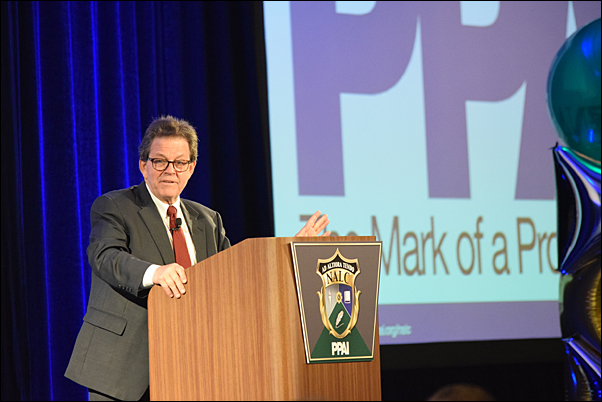NALC Opens Monday With Economist Dr. Arthur Laffer
 The 2016 PPAI North American Leadership Conference (NALC) kicked off in earnest Monday morning in San Francisco with an opening session led by famed economist Dr. Arthur Laffer. Laffer, whose presentation focused on the economy and the potential impact of the election, has been called the father of supply-side economics and is credited with triggering a worldwide tax-cutting movement in the 1980s. The Laffer Curve is one of the main theoretical constructs of supply-side economics, illustrating the tradeoff between tax rates and actual tax revenues.
The 2016 PPAI North American Leadership Conference (NALC) kicked off in earnest Monday morning in San Francisco with an opening session led by famed economist Dr. Arthur Laffer. Laffer, whose presentation focused on the economy and the potential impact of the election, has been called the father of supply-side economics and is credited with triggering a worldwide tax-cutting movement in the 1980s. The Laffer Curve is one of the main theoretical constructs of supply-side economics, illustrating the tradeoff between tax rates and actual tax revenues.
At NALC, Laffer brought to bear a career marked by experience and success in business, in public policy, and as an academic economist and professor. Laffer was a member of President Reagan’s Economic Policy Advisory Board for both of his terms. He was a member of the Executive Committee of the Reagan/Bush Finance Committee in 1984, a founding member of the Reagan Executive Advisory Committee for the presidential race in 1980, and he advised Prime Minister Margaret Thatcher on fiscal policy in the UK during the 1980s. A former professor at Pepperdine University and a member of the Pepperdine Board of Directors, Laffer currently lives in Nashville, Tennessee, where he is founder and chairman of Laffer Associates, an economic research and consulting firm, and Laffer Investments, an institutional investment management firm.
Peppered with anecdotes about his time working with President Reagan and his consultations, meetings and friendships with former California Governor Arnold Schwarzenegger, political consultant James Carville, Vice President Al Gore and others, Laffer’s session framed and highlighted the power of economics in governing growth and development in U.S. federal and state economies.
Throughout his presentation, Laffer drew on his research on how states’ tax policies have impacted their growth and success. Since 1960, 11 states have adopted state income taxes, most recently Connecticut in 1991. Measuring a number of metrics in those 11 states from the three years prior to implementing a state income tax and the two most recent years, Laffer found that in every single one of those states, they declined against the other 39 states in every metric measured.
But why did they introduce these taxes, Laffer asked, if this is what happens? Because, he says, in towns and states all over the country there are conversations about needing better schools, highways and other things. “No one wants zero tax, as much as no one wants 110-percent tax,” he says. “We’re arguing within a range in which we all operate.”
However, he notes, economics is all about incentives. Laffer says, “People respond to incentives. It’s an incentive-driven world. If you tax people who work and you pay people who don’t work, don’t be surprised [when] people don’t work.”
Turning toward the upcoming election, Laffer described the current U.S. economy as the single worst recovery in U.S. history. Compared against the Reagan recovery, the country is about $4 trillion behind and employment is short around 11 million jobs. And whenever you have an economy like this, you almost always have a flip at the top.
These flips are typically bottom-up. While he noted turnout during the Republican primaries was up by about 62 percent compared to 2008—while Democratic turnout was down 22 percent—this flip is already evident in state legislatures, governors’ mansions and in the House of Representatives and Senate. Laffer said he wasn’t certain if this flip would reach the White House in November—he stressed that he was speaking purely on economic issues and not other concerns like social issues and foreign policy that shape an election.
Ultimately, there are five factors that he said he wants to see in a sound economic policy:
- A low rate, broad rate, flat tax.
- Spending restraint. “There are limits to government spending.”
- Sound money. “There is very little that brings an economy to its knees like unsound money.”
- Free trade. “The least amount of impediments across boundaries for goods and services.”
- Minimal regulations. “We all understand the need for regulations, but you want to make sure they don’t go beyond the specific regulations and impact the economy.”
While critical of many aspects of the current economic landscape, Laffer’s session ended on an optimistic note. “When the current economy is over,” he says, “you are going to see one of the greatest economies you’ve ever known.”

